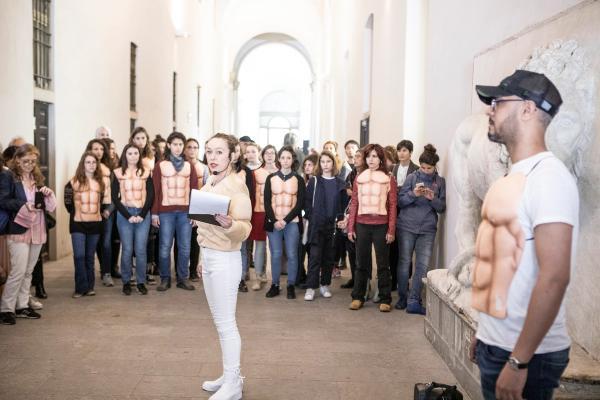
And Their Spirits Live On
2019
Performance
The work consists of a guided tour in the corridors of Accademia di Belle Arti di Brera in Milano, Italy, of which Marianne Heier is a former student. In Oslo the tour is transposed to the ‘bank hall’ of the now closed former Museum of Contemporary Art.
Ph. from performance in Oslo by Kristine Jakobsen
Ph. from performance in Milan by Stefano Campo Antico
Cast copies of famous sculptures are fundamental in the art academy teaching tradition. They ground the institution’s activities in the classical art canon, and different selections and editions can be found in almost all Western European art-educational institutions and museums. In the artist’s monologue, the heroic undertone of the sculptures and the mythologies they represent are the starting point for a study in civil courage throughout time and space. Read through our current political climate, the phantom-like works from a lost era re-appear as relevant and effective. Critiques of power, gender and identity are central to the stories behind them, and relate them directly to our current political movements. Indirectly the work also poses questions about ownership, and the power to define art history, and which interests it can be instrumentalised to serve. In Heier’s work, the stories behind the iconic Accademia cast collection, displayed in the school’s hallways and shared spaces, are interpreted and performed as stories of communities and commons. They represent basic forms or archetypes, an aesthetic and political vocabulary we still utilise and refer to, often without being aware of it. Thus, their continued relevance is enacted through us.
The monologue presented by the guide borrows from the narratives of classical mythology, and juxtaposes them with quotes from modern manifestos and speeches. The title is borrowed from the last flyer produced by the student resistance group ‘die Weiße Rose’. It was distributed over München from allied forces’ planes in July 1943, after several of the group’s core members were executed by the Nazis. Through this title, the performance directly addresses itself to today’s youth, to students of art, and passes on the stories carried by these classical sculptures to those who own the future.
Performancen har form av en guidet omvisning i gipssamlingen i korridorene til Accademia di Belle Arti di Brera i Milano, der Heier selv har vært student. I Oslo vises den i Banksalen i det fraflyttede Museet for samtidskunst.
Gipskopier av ikoniske skulpturer er grunnleggende i tradisjonell kunstakademisk utdanning. De forankrer kunstinstitusjonenes virksomhet i den klassiske kunstkanonen, og forskjellige utvalg og utgaver finnes ved nærmest alle vesentlige europeiske kunstutdanningsinstitusjoner og museer. I guidens monolog blir den heroiske grunntonen i skulpturene utgangspunkt for en studie i sivilt mot gjennom tid og rom. Lest opp mot våre dagers politiske klima, gjenoppstår de spøkelsesaktige verkene fra en annen tid som relevante og virksomme. Maktkritikk, kjønnsproblematikk og identitet er sentrale i historien bak flere av dem, og knytter an til vår tids politiske spørsmål. Indirekte stiller verket også spørsmål om eierskap og definisjonsmakt til historien om kunsten, og hvilke interesser den skal tjene. I Heiers arbeid blir historiene bak kunsthistoriens ikoniske verk lest som fellesskapets fortellinger. De er grunnformer eller arketyper, et estetisk og politisk vokabular vi stadig refererer til, ofte uten å være klar over det selv. De lever videre gjennom oss.
Guidens monolog låner mesteparten av narrativet fra klassisk mytologi, og kryssklipper det med sitater fra politiske manifester og taler. Tittelen er lånt fra det siste flygebladet til studentmotstandsgruppa die Weiße Rose. Det ble spredd over München fra de alliertes fly i juli 1943, etter at flere av gruppas sentrale medlemmer var blitt halshugd av nazistene. Slik henvender performancen seg til de unge, til kunststudentene ved Brera og Prosjektskolen, og sender historiene bak skulpturene i samlingen videre til de som eier fremtiden.